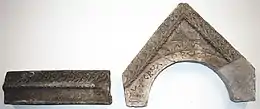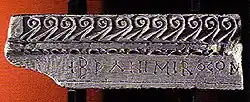| Branimir inscription | |
|---|---|
 Branimir inscription | |
| Created | 888[1] |
| Location | Šopot, near Benkovac, Croatia |
| Purpose | Templon beam and gable inscription |
The Branimir inscription (Croatian: Natpis kneza Branimira) is the oldest preserved monument containing an inscription defining a Croatian medieval ruler as a duke of Croats – Dux Cruatorum. The inscription was originally a part of templon of a church in Šopot at Benkovac built by Duke Branimir, who ruled Croatia from 879–892.
Description
The inscribed beam and gable fragments contain a Latin language reference to Branimir as BRANIMIRO COM[ES]… DVX CRVATORṼ COGIT[AVIT]… ("the count Branimir… considered duke of the Croats…"). The first two words are inscribed on the 67 by 21 cm (26.4 by 8.3 in) beam fragment, and the rest on the 74 to 81 cm (29 to 32 in) wide and 65 cm (26 in) tall gable fragment. Both of the fragments have matching ornamentation along the top edge, with a cross executed in Croatian interlace on the gable and a pair of birds, one to either side of the cross. The fragments were originally parts of a templon in a church completed in the 9th century and consecrated to Saint Jerome. The church was built by Branimir, who reigned in 879–892. The inscription is kept in Museum of Croatian Archaeological Monuments in Split.[2][3]

The inscription is significant for the history of Croatia as it represents one of the oldest surviving references to a Croatian ruler, but also the earliest fully recorded use of the particular name for Croats.[3][4] There are five other preserved stone inscriptions mentioning Branimir, found in Nin, Ždrapanj near Skradin, Otres near Bribir, in Muć Gornji near Split, and latest found in Lepuri near Benkovac.[5] The one found in Muć contains the consecration year, dating the inscription to year 888.[6][7]
The oldest epigrahic inscription of a Croatian ruler are most probably those of Mislav of Croatia.[5] A possibly older references to a Croatian ethnonym have been confirmed in a church inscription found in Bijaći near Trogir dated to the end of the 8th or early 9th century;[4] and a charter of duke Trpimir I of Croatia from the year 852, however, its original is lost, and analyses of its 1568 copy indicate it might not indeed be older than the Branimir inscription.[8]
References
- ↑ Supičić, Ivan (1999). Croatia in The Early Middle Ages: a Cultural Survey. Philip Wilson. p. 200. ISBN 0-85667-499-0.
- ↑ "Natpis kneza Branimira" [Duke Branimir Inscription] (in Croatian). Benkovac Tourist Board. Retrieved 22 October 2011.
- 1 2 Ivan Mužić (2007). Hrvatska povijest devetoga stoljeća [Croatian Ninth Century History] (PDF) (in Croatian). Naklada Bošković. pp. 195–198. ISBN 978-953-263-034-3. Archived from the original (PDF) on 8 August 2019. Retrieved 14 October 2011.
- 1 2 "Kulturna kronika: Dvanaest hrvatskih stoljeća". Vijenac (in Croatian). Zagreb: Matica hrvatska (291). 28 April 2005. Retrieved 10 June 2019.
Analizom je utvrđeno da je taj kameni ulomak ne samo najstariji pronađen spomenik s hrvatskim imenom uopće (do sada je to bio osamdesetak godina mlađi natpis kneza Branimira, pronađen kod Benkovca) nego i najstariji zabilježen institut župana u Hrvatskoj u ranom srednjem vijeku.
- 1 2 Josipović, Ivan (2018). "Tri nova posvetna natpisa s imenima hrvatskih vladara iz karolinškog perioda" [Three New Votive Inscriptions With the Names of Croatian Rulers from the Carolingian Period]. Starohrvatska Prosvjeta. III (44–45): 137–151. Retrieved 24 January 2023.
- ↑ Florin Curta (2006). Southeastern Europe in the Middle Ages, 500-1250. Cambridge University Press. p. 140. ISBN 978-0-521-81539-0. Retrieved 22 October 2011.
- ↑ Ivan Botica (November 2006). "Recenzija, Prikaz - Na izvorima hrvatskoga zapadnoeuropskog identiteta, Mirjana Matijević Sokol - Vladimir Sokol (2005)" [Review - At the Sources of Croatian West European Identity, Mirjana Matijević Sokol - Vladimir Sokol (2005)]. Radovi Zavoda Za Hrvatsku Povijest (in Croatian). University of Zagreb, Faculty of Philosophy. 38 (1). ISSN 0353-295X. Retrieved 24 October 2011.
- ↑ Ivan Mužić (2007). Hrvatska povijest devetoga stoljeća [Croatian Ninth Century History] (PDF) (in Croatian). Naklada Bošković. p. 27. ISBN 978-953-263-034-3. Archived from the original (PDF) on 8 August 2019. Retrieved 14 October 2011.